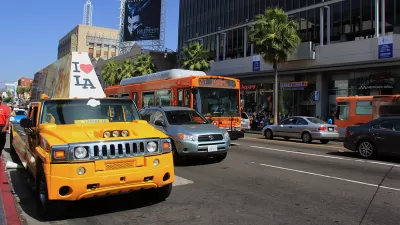A long-awaited draft update of the California Environmental Quality Act (CEQA) has finally been released, and Level of Service will finally be a thing of the past in the next two to four years.

The California Governor’s Office of Planning and Research recently released a large revision of the California Environmental Quality Act (CEQA), including a highly anticipated change from Level of Service (LOS) to Vehicle Miles Traveled (VMT) as the measure of environmental impact. The change was mandated by SB 743, approved in 2013 and covered extensively by Planetizen.
Melanie Curry reports on the big CEQA update as the overhaul will switch gears:
Now that the guidelines [pdf]—including a separate Technical Advisory on the SB 743 changes [pdf]—have been released, the Natural Resources Agency will conduct a formal “rulemaking” process, with more public feedback and discussion, which might bring further changes to the proposed guidelines.
Curry also notes that the guidelines took a painfully long time to deliver, but the "proposed timeline for final implementation is two years from now, in January 2020, according to the Caltrans website."
As for how the rules will take effect in local jurisdictions, Curry explains: "The rules will go into effect as soon as they are adopted, but cities will have two years after that to figure out the switch to the VMT measure." Pasadena, San Francisco, and Oakland [pdf] have already switched to VMT in environmental reviews.
FULL STORY: After 4 Years, Key Rule Requiring Development to Account for New Miles Driven Moves Forward

Maui's Vacation Rental Debate Turns Ugly
Verbal attacks, misinformation campaigns and fistfights plague a high-stakes debate to convert thousands of vacation rentals into long-term housing.

Planetizen Federal Action Tracker
A weekly monitor of how Trump’s orders and actions are impacting planners and planning in America.

In Urban Planning, AI Prompting Could be the New Design Thinking
Creativity has long been key to great urban design. What if we see AI as our new creative partner?

The Vast Potential of the Right-of-Way
One writer argues that the space between two building faces is the most important element of the built environment.

Florida Seniors Face Rising Homelessness Risk
High housing costs are pushing more seniors, many of them on a fixed income, into homelessness.

Massachusetts Budget Helps Close MBTA Budget Gap
The budget signed by Gov. Maura Healey includes $470 million in MBTA funding for the next fiscal year.
Urban Design for Planners 1: Software Tools
This six-course series explores essential urban design concepts using open source software and equips planners with the tools they need to participate fully in the urban design process.
Planning for Universal Design
Learn the tools for implementing Universal Design in planning regulations.
Gallatin County Department of Planning & Community Development
Heyer Gruel & Associates PA
JM Goldson LLC
City of Camden Redevelopment Agency
City of Astoria
Transportation Research & Education Center (TREC) at Portland State University
Jefferson Parish Government
Camden Redevelopment Agency
City of Claremont



























